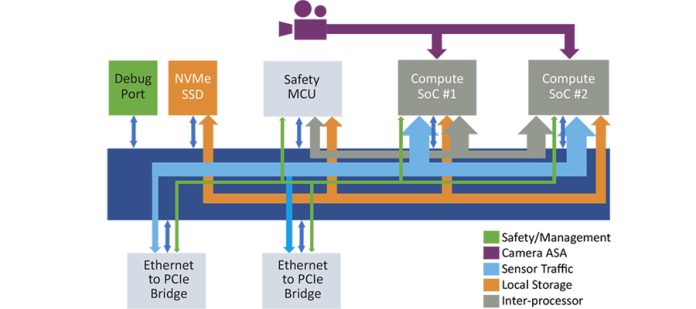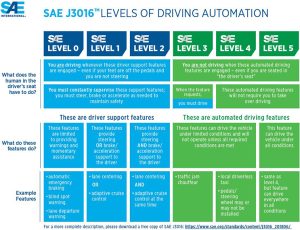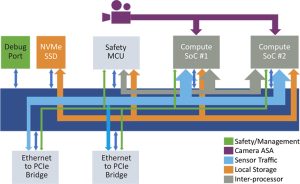David Schellenberger, Microchip Technologies
The autonomous vehicle is a complex system that requires large amounts of real-time data, cloud connectivity and fast, safe and secure decision making—it’s like a data center on wheels.
Hardware in Next-Generation Software-Defined Vehicles
As today’s cars adopt higher levels of automation (see Figure 1), they incorporate increasingly sophisticated combinations of electronic components: Central Processing Units (CPUs), Electronic Control Units (ECUs), Graphics Processing Units (GPUs), New Acoustic Dimensions (NADs), Systems-on-Chips (SoCs), sensors, accelerators and storage devices. The architecture and communication between the electronic components must be carefully designed to meet stringent safety, reliability, performance, cost and latency demands.
Figure 1 (Source: SAE International)
Within a vehicle, there are many ECUs that combine across separate zones based on a common functionality. These zonal ECUs communicate to high-performance compute platforms using Ethernet. Within the compute platform, there is a need for high-bandwidth processing to ensure that real-time decision making happens safely. Peripheral Component Interconnect Express (PCIe) technology is being used by automotive designers in a manner very similar to how a data center is designed. Connecting sensors with high-speed serial outputs to processing units is best addressed with an open standard called Automotive SerDes Alliance (ASA).
Heterogenous Architecture for Advanced Driver Assistance Systems (ADAS)
The figure below displays an architectural diagram showing how the three types of connectivity data flows work together in a high-performance compute platform.
Figure 2
At the top of the diagram, a video camera connects to multiple compute SoCs using the ASA Motion Link SerDes (purple) for the high-speed serial data, scaling from 2 to 16 Gbps. The width of the traffic data connections is an indication of its relative bandwidth. This ASA Motion Link standard may also be used to connect displays, separated from the Ethernet traffic. More compute SoCs can be added as higher levels of autonomy are sought and more sensors are added.
On the bottom of the diagram shown in blue are two Ethernet bridges going to the zonal ECUs within the vehicle; the symmetric point-to-point IP-based connectivity bandwidth can scale up to 10 Gbps. Each of these Ethernet bridges is carrying other sensor traffic, from various zones. Additional Ethernet to PCIe bridges may be added for new zones to support scaling for higher levels of autonomy.
Local storage is displayed as an orange box using NVMe technology. Multiple compute sources, such as SoCs and safety microcontrollers (MCUs), need to access this storage at high speeds, so the interconnect is handled through a PCIe switch (in dark blue). Using PCIe Gen4, the symmetric point-to-point connectivity can range from 16 to 64 Gbps (4 lanes) per port.
The safety MCU has low-bandwidth control signals shown by the yellow arrows inside the PCIe switch. For engineering debug purposes, there’s a green debug port shown on the left side connected to the PCIe switch.
The Advantages of Combining PCIe, Ethernet and ASA
Although the three communications technologies evolved at different times to support different needs, the heterogeneous architecture takes advantage of the strengths and tradeoffs of each of them—and PCIe pulls it all together.
The PCIe standard was created in 2003 by Intel, Dell, HP and IBM, targeting desktop and laptop devices to connect the graphics card to the CPU and main memory. It has evolved over the years to include up to 16 lanes of traffic and there are six-speed versions, so its use has now expanded into data centers and automotive systems. Packets are used in PCIe, along with error checks at multiple layers: transaction, data link and physical. The PCIe hardware guarantees error-free transactions, making for a reliable transport mechanism and well suited for mission-critical vehicle usage. Even the latency of PCIe is shorter than Ethernet, making it a great choice for inter-process communications used by ADAS.
We offer a family of PCIe switches that can be used in vehicle ADAS applications. The SwitchTec PFX Fanout PCIe Switch family is the world’s first automotive-qualified PCIe switch family and offers 28-, 36- and 52-lane versions with industry-leading features, flexibility and performance.
Ethernet was first developed in the 1970s and is an established standard used worldwide for all computer networking, so it’s a smart choice for automotive in-vehicle networking use, meeting cyber security and networking demands. The speeds of Ethernet are also much higher than previous standards like CAN, CAN FD, FlexRay and MOST technology. Multi-gig automotive Ethernet standards for 2.5 Gbps, 5 Gbps and 10 Gbps are defined by the IEEE® 802.3ch working group. With single, twisted-pair (UTP) cabling, Ethernet is both lightweight and low cost, ideal for automotive use. We offer a full line of Ethernet switches and PHYs for automotive use.
We’ve now reached an era of software-defined vehicles and it’s exciting to see all the new ADAS features being added from vendors across the globe in a competitive race to reach the goal of Level 5 autonomous driving. PCIe, Ethernet and ASA complement each other and this combination of networking standards is positioned to meet the needs of automotive designers now and in the future.










